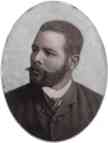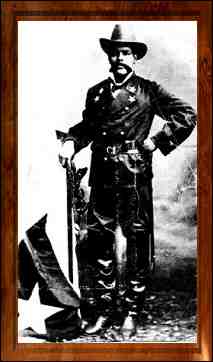

March 20. María Josefa Eufemia Cabrales is born in San Luis, Oriente Province. (She later becomes Antonio Maceo's wife.)
Marcos Maceo and Mariana Grajales y Cuello enter into a common law marriage.
June 14. Antonio Maceo is born in Majaguabo, San Luis, Oriente Province. Antonio is the first of Marcos and Mariana's nine children. Read about the controversy over Maceo's birthday.
August 26. Antonio Maceo is baptized at the Church of Santo Tomás Apóstol.
February 20. Maceo's first sister, María Baldomera is born.
February 2. Maceo's first brother, José Marcelino is born. José is Marcos and Mariana's 3rd child.
October 24. Maceo's brother, Rafael, is born.
July 6. Marcos Maceo and Mariana Grajales legitimize their common-law marriage before parish priest José Tomás Chamorro, of the Church of San Nicolás de Morón y de San Luis, Oriente.
September 16. Miguel, Maceo's brother, is born.
May 20. Julio, Maceo's brother, is born.
May 11. Dominga de la Calzada, Maceo's sister, is born.
December 25. José Tomás, Maceo's brother, is born.
September 24. Marcos, Maceo's brother, is born.
Maceo joins the Masonic Lodge of Santiago de Cuba (and enters the inner revolutionary circle).
February 16. Maceo marries María Magdalena Cabrales y Fernández. They move into a home in La Esperanza, one of the Maceo family farms.
November. Maceo’s first daughter is born: María de la Caridad Maceo.
Early in the year, the Spanish government imposes a new tax on the island ranging from 6 to 12 percent on real estate, incomes and all types of business. This is on top of the enormous customs duties about which Cubans have continuously complained.
February 24. In Puerto Rico, an uprising known as the Grito de Lares begins.
August 4. At a coordinating meeting for revolutionary activities (on a farm named San Miguel de Rompe, in Las tunas) Carlos M. de Céspedes makes a passionate plea for immediate action, ending with the words: “Gentlemen, the hour is solemn and decisive. The power of Spain is decrepit and worm-eaten; if it still appears great and strong to us, it is because for more than three centuries we have contemplated it from our knees.”
September 18. Isabel II, Queen of Spain, is dethroned.
September 23. In Puerto Rico, the historic rebellion of Lares breaks out, and the Revolutionary Junta proclaims a free Puerto Rican Republic.
Early in the month a telegram from General Lersundi to governor of Bayamo Udaeta, is intercepted by a telegrapher friendly to the revolutionaries. It reads: “Cuba belongs to Spain and for Spain she must be kept no matter who is governing. Send to prison D. Carlos Manuel de Céspedes, Francisco Vicente Aguilera, Pedro Figueredo, Francis Maceo Osorio, Bartolomé Masó, Francisco Javier de Céspedes…”
October 10. From his plantation, La Demajagua, near Yara, Carlos Manuel de Céspedes proclaims Cuban independence in the historic “Grito de Yara.” Joined by 37 other planters, he liberates his slaves and incorporates them into a rebel army.
October 12. First clash with Spanish troops at Yara. The rebels eat supper at the Maceo house in Majabuabo. After the meal, Marcos Maceo donates four ounces of gold, a dozen good machetes, two revolvers, four shotguns and a blunderbuss. Antonio and José Maceo, with half-brothers Justo Regüeyferes Grajales, join the rebels. Mariana Grajales: "Everyone, parents and children, kneel before Christ, who was the first liberal man who came to the world, and swear to free the country or die for her." [Justo was later captured and executed while trying to visit his wife. He was the first of Mariana's 8 sons to die for Cuban independence.]
At this point, Spain has only 7,000 regulars on the island, and a Volunteer force armed with 90,000 Remington rifles purchased in the U.S. It is the volunteers that allow Spaniards to contain the rebellion until reinforcements arrive.
The rebel army, known as the mambises, consists initially of 147 volunteers who do not even have a weapon each. Their weapons consist of 45 fowling pieces, 4 rifles, and a few pistols and machetes.
October 28. Ten days after capturing the city of Bayamo, the Revolutionary Municipal Council of Bayamo petitions Céspedes to proclaim the immediate abolition of slavery.
November. The Rebel Army now has 12,000 men.
At the battle of "El Cristo” and “El Cobre,” Maceo shows exceptional courage, initiative and leadership. He is quickly promoted to sergeant, and then to captain.
In Bayamo, Maceo achieves a victory that his commander, Colonel Pio Rosado, declared impossible. General Mármol later praises him.
November 1868 through December 1869. Spain sends its finest officers to command 35,000 veteran soldiers and thousands of others. It also sends 14 warships and a train of artillery equipped with latest model Krupp cannons.
December 27. Céspedes signs a decree declaring Cuba incompatible with slavery, but adding that slavery will end "when it had full use of its powers under free suffrage so that it could agree on the best means of carrying the proposal to and end that would be advantageous to the old as well as the new citizen." [Meaning a gradual and indemnified abolition to happen after the war.]
January 7. Spanish General Valmaseda outmaneuvers Marmól and surprises Cuban forces at El Saladillo. More than 2,000 Cubans die in this encounter, most of them are recently freed slaves.
January 16. Maceo is promoted to commander. He begins to operate with independent forces, still under the jurisdiction of General Marmól. With this new freedom to “formulate his own tactics,” achieves victories in Mayari and Guantánamo.

January 26. Maceo is promoted to lieutenant colonel of the Liberating Army.
Historian Philip Foner, from his book Antonio Maceo:
“On many occasions, Spanish officers were completely fooled by
Maceo’s whirlwind attacks against their superior forces. When the initial
attack was repulsed and the seemingly desperate retreat was followed up by the
Spaniards, they found themselves suddenly trapped in a well-prepared ambush on
unfavorable terrain. Maceo delighted in outsmarting the Spanish generals; again
and again, he decoyed them into situations that were disastrous to them.”
February 9. Under General Federico Cavada (a former colonel in the U.S. Volunteer Service during the Civil War) the Las Villas district joins the war for independence..
February 26. The Revolutionary Assembly of the Central Department in Camagüey issues a declaration that states: “The institution of slavery, introduced into Cuba by Spanish Dominion, must be extinguished along with it.”
March 19. U.S. President Grant's cabinet makes its first major decision on a Cuban policy. Nearly all members of the cabinet, led by Secretary of State Hamilton Fish, are opposed to the recognition of Cuban belligerency.
April 10. The Constitutional Convention meets at Guaimaro. A constitution is adopted that provides for a republican government. Article 24 declares, that "all the inhabitants of the Republic are absolutely free."
May 14. In a fierce and bloody battle at San Agustín, Sergeant Marcos Maceo (Antonio Maceo's father) is killed in battle (by a Spanish bullet) at the side of his son. In his book, Antonio Maceo, Foner says, "Mariana Grajales, living incarnation of Cuban patriotism, cried out to the youngest of her sons, still a little boy: 'And you, stand up tall; it is already time that you should fight for your country.'"
In A History of Cuba and its relations with The United States, Volume 2, historian Philip S. Foner writes: “Indeed, as a passionate patriot and foe of the Spaniards, this Negro woman, Mariana Grajales, one of the outstanding women in Cuba’s revolutionary history, swayed her entire family to the cause of independence.”
May 22. In an attack at the strongly defended sugar mill, “Armonia,” Maceo receives the first of twenty-four wounds. He is carried back to a hidden rest camp, where his wife and his mother nurse him back to health.
A few weeks later, Maceo's two small children die of disease, possibly cholera.
Late in the month, an expedition organized by the New York Junta, made up of 800 to 1,400 men equipped with Spencer carbines, revolvers, sabres, two batteries of 12-pounder, and several 60-pounder guns, is intercepted by U.S. federal authorities and most of the men are taken prisoner.
Historian Philip Foner, from the book Antonio Maceo:
“What the Cuban army lacked in numbers, experience, warfare training
and arms and equipment was often compensated for by their thorough knowledge of
the country, effective use of guerrilla tactics, greater immunity to cholera
and other diseases that flourished on the island, and above all patriotic
devotion. The most important asset of guerrilla warfare is an ideal; the rebels
were fighting for the liberation of their country, and this gave them the
popular support without which a guerrilla movement cannot be effective.
‘Every tree and flower and grass had a use or a virtue with which they
seemed acquainted,’ reported James J. O’Kelly, the Irish journalist.
The guajiro and the campesino, the slave and the free black, not
only moved steadily into the ranks of the Liberating Army, but aided and
shielded the patriotic fighters, even though they risked their own lives by so
doing.”
August 7. Don Ascencio de Ascencio (Maceo's godfather) and Exuperancio Alvarez (Maceo's friend) are executed by a Spanish firing squad.
By the end of the year, Spain has amassed a powerful fleet that includes the vessels Victoria and Zaragoza. This proves to be a major advantage, since the rebels had no navy and Spain is easily able to keep outside aid from getting through.
The rebel army is forced to abandon the province of Las Villas, the most western point of the rebellion, and fall back to Camagüey. However, Spaniards are constantly on the run in Santa Clara, Camagüey and Oriente provinces.
June 14. Antonio Maceo celebrates his 25th birthday.
June 26. General Donato Marmól is killed. General Máximo Gómez is placed in command of Maceo’s area. Gómez and Maceo become dominant military figures.
July 20. Gómez reorganizes his forces. General Calixto García becomes second in command, and Lieutenant Colonel Antonio Maceo is put in charge of the third battalion.
Heading a battalion of only 187 men, Maceo takes part in numerous successful attacks under Gómez’s command.
October 2. After defeating a Spanish attack on his camp in Majaguabo, Maceo receives another severe battle wound. By the twentieth he’s active again, taking part in the highly successful assault on the town of Ti-Arriba, which results in the destruction of the town and the capture of a large quantity of booty.
November 7. At General Headquarters, Máximo Gómez speaks fondly of Antonio Maceo, referring to him as "a soldier's soldier in or out of battle."
December 4. During an attack on the fortress of Baragua, Maceo is wounded again. His younger brother, Julio, dies in the same battle. Even as his wounds are healing, Maceo is able to defend against Spanish troops that venture near his camp.
Maceo Timeline - Part 1 | Part 2 | Part 3 | Part 4
Related:
Articles about
Antonio Maceo